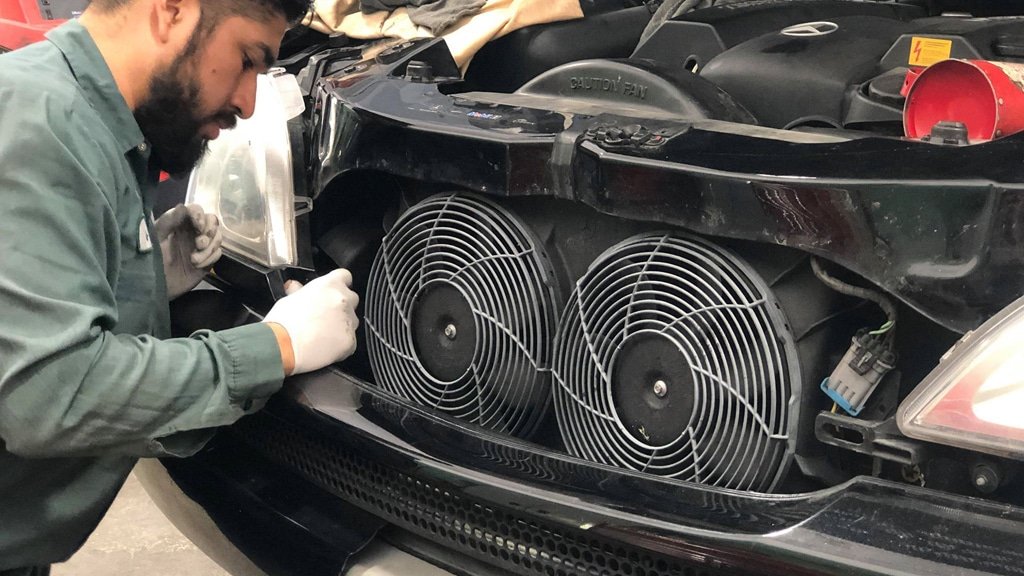When the electric cooling fan does not come on you risk overheating your engine and compromising your air conditioning system. The Columbia SC Auto Repair Pro has more details on troubleshooting problems with your electric cooling fan now.
Electric Cooling Fan – How It Works
Your electric cooling fan is usually mounted just behind the radiator. On vehicles that have a large, wide radiator you may even have two cooling fans. Sometimes there is a separate fan that is for the air conditioning condenser.
The fan or fans only run when they are needed to help cool your engine down. The engine coolant sensor (or sometimes an engine temperature switch) monitors the engine temperature. A cooling fan does not come on until the engine has reached the normal operating temperature of 195 to 215 degrees. At that point, your electric cooling fan begins to cycle on and off maintaining the proper coolant temperature. This means that your fan runs more often than not at idle or low speeds because this is when the engine is at a higher than normal temperature.
Your fan will sometimes continue running when the engine is shut off. This is part of normal operation, but it should shut off within several minutes once your engine cools off.
Your electric cooling fan will also come on while the A/C is on. It does this to provide extra airflow through your condenser enabling better cooling performance. This will occur regardless of your engine temperature or the speed of your vehicle.
Without the A/C on, your fan is usually not necessary if the vehicle is traveling fast enough. At speeds over 30mph there is usually enough airflow through your grille to provide adequate cooling.
Mechanic Tip:
WORK with EXTREME CAUTION:
On many vehicles the fan circuits are wired to enable the fan to be able to come on even if the engine is not running. Be conscious of this when working in a hot engine compartment. Always keep your fingers and tools away from the fan and fan blades.
Cooling Fan Electrical Circuit
The temperature-sensing power circuit for your cooling fan only runs when additional cooling is required. On older vehicles your fan operation is typically managed by a temperature switch that is found in your radiator or on the engine itself. When coolant temps surpass the switch\’s temperature rating (usually 195 to 215 degrees), the switch will close and a relay in your engine compartment then supplies the voltage to your cooling fan. The fan should then run until the coolant temperature has dropped to a temperature that is below the opening point for the switch. While operating your air conditioner, a separate circuit turns the fan on if your A/C compressor clutch is engaged.
In vehicles that have computerized engine controls, the fan operation is commonly regulated by your powertrain control module or PCM. Your PCM uses input from your coolant sensor, and sometimes the vehicle speed sensor, to determine if the fan should be engaged. The PCM may also be responsible for selecting between either low or high fan speeds.
Electric Cooling Fan Common Problems
Whether the fan fails to work or a fan relay stops responding, is means trouble. Without being repaired, it will likely cause your engine to overheat.
Here are a few things that may be preventing your electric cooling fan from coming on:
- Faulty coolant sensor or temperature switch
- Thermostat stuck in OPEN position
- Failing or bad fan relay
- Wiring problems – This could range from a blown fuse to loose or corroded connector, electrical shorts, or other similar issues.
- Faulty or bad fan motor
How To Check Your Electric Cooling Fan
An easy, quick check for your fan circuit is to simply start your engine and turn the A/C up all the way. If your fan is running, all may seem to be well, but you still will not know if your temperature switch or the temperature sensor and PCM are turning the fan on when the coolant temperatures are getting high.
To check this, you need to turn the A/C off but keep the engine running. You need to let it run until it can reach normal operating temperatures. Most fans will come on once your coolant hits about 200 to 230 degrees. If your fan does not come on, your problem is probably a defective control circuit. You now need to check resistance on your temperature sensor or switch, as well as a voltage check on both sides of your relay. I suggest using a wiring diagram of the fan cooling circuit for your particular vehicle to properly identify your relay terminals and wiring connections. This can be found in your owner’s manual and usually by an internet search.
The fan motor itself can quickly and easily be checked just by using jumper wires. First, unplug the wiring connector on your fan. Now use the jumper wires coming from your battery to route the power straight to your fan. Your fan should start spin at a normal speed as soon as it is supplied with 12 volts. If you are hearing noisy bearings or are experiencing a fan speed that is slower than it should be, you are probably dealing with a worn and failing fan motor.
If you are having a problem with the electric cooling fan and need a professional mechanic to diagnose and repair your fan, come to Sanford’s Automotive Service in Columbia, SC. Our full service auto repair shop can get you taken care of and back on the road before you know it. Stop by Monday through Friday or schedule a Saturday appointment by calling 803-735-7902.

